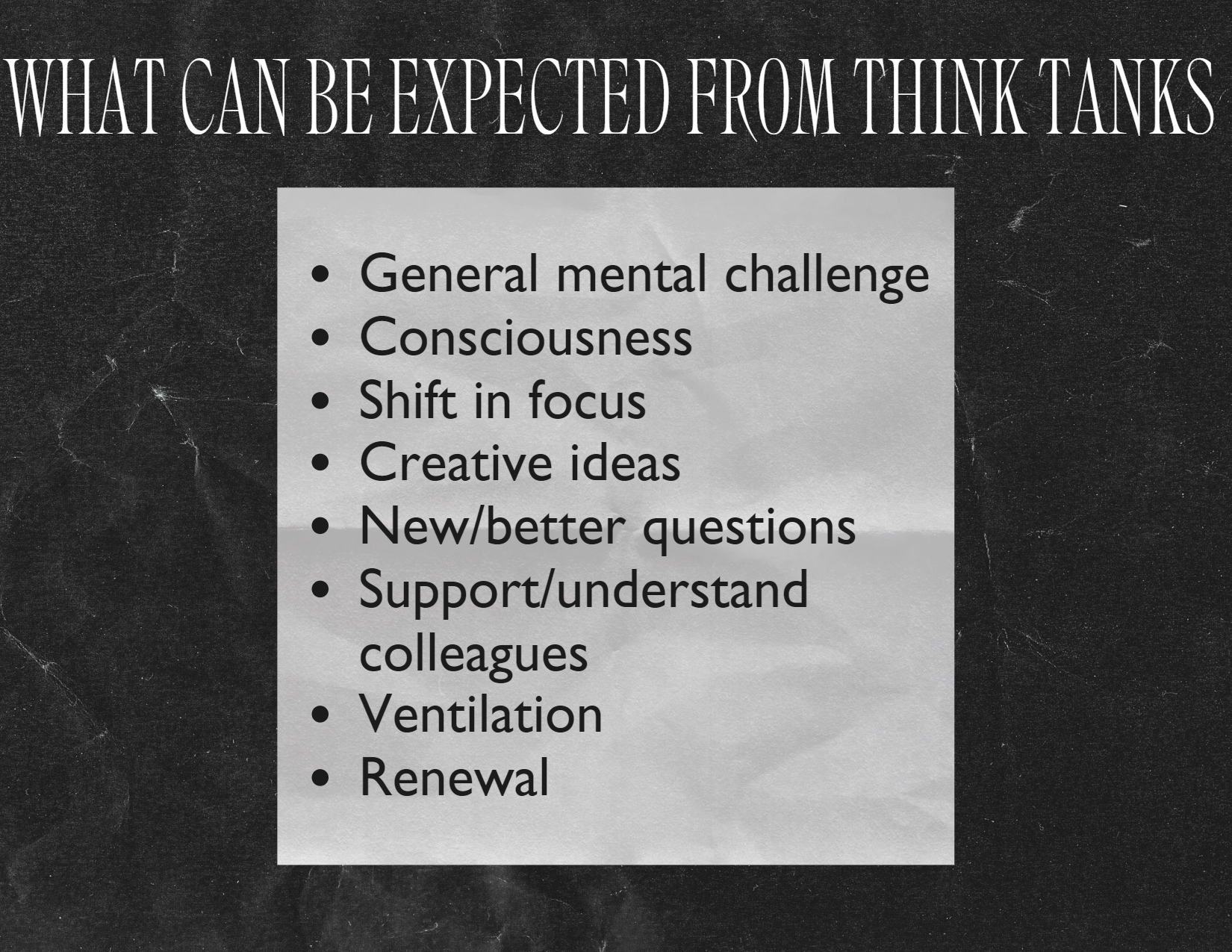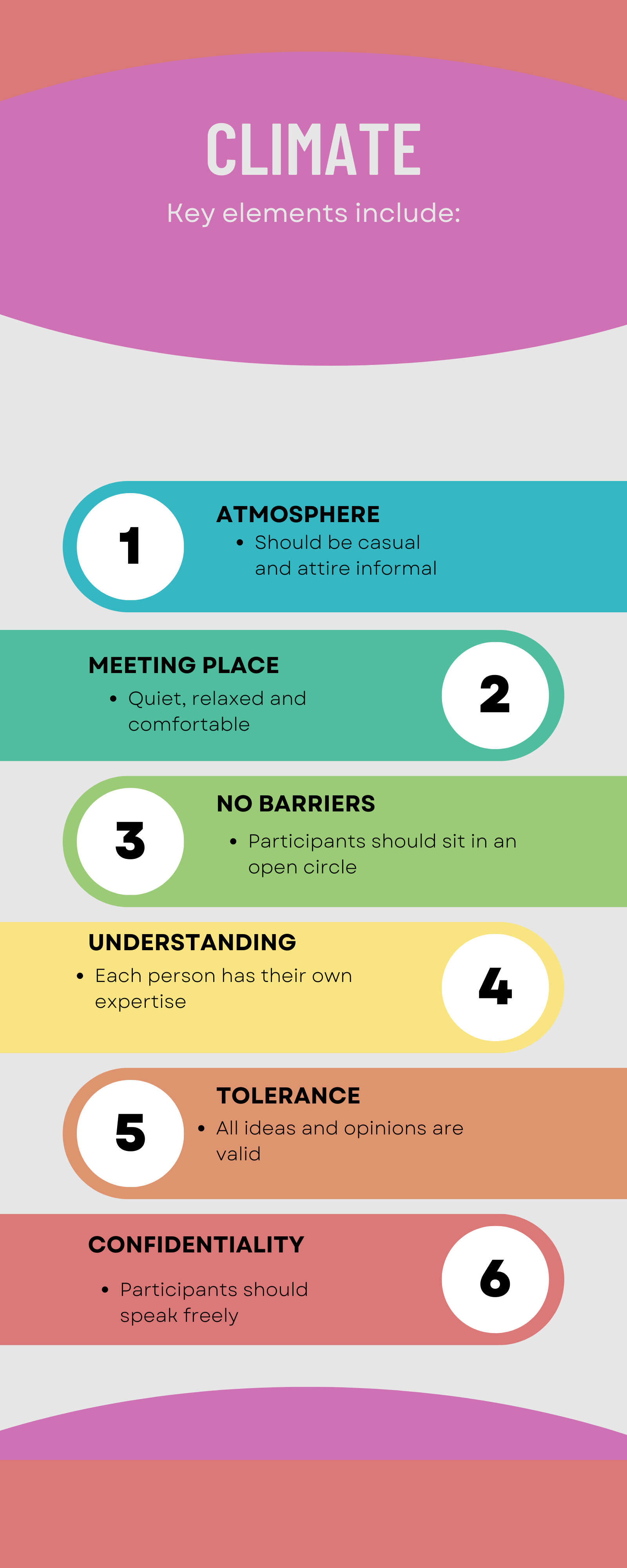Click here to view a video that explains what a think tank is.
The primary method of learning and problem-solving involved in workshops, conferences, consultations and materials related to specific areas of volunteer administration. All must usually be relatively structured resources directed to goals, tasks, and immediate problem resolution. Each of these addresses the very real needs of volunteer leadership. The think tank process endeavours to step beyond practical needs and…
- Challenge advanced or restlessly creative leaders. Provide powerful tools for dealing with deeper and longer-range issues.
- Develop holistic thinking patterns.
- Stimulate creativity in a field which today seems far more concerned with standardization.
The basis of these expectations lies in the outcome and feedback of dozens of think tanks held over the past decade. However, think tanks still remain relatively rare, and somewhat an elitist phenomenon.
What Is a Think Tank
The term "think tank" (some prefer "reflection pool") is relatively new. Most reference sources define a think tank in terms of an organization or group focused on the resolution of a particular problem or task, particularly in the realms of science and technology. However, it is believed that the think tank is better defined in terms of a process rather than a structure. Therefore, for the purpose of these guidelines, a think tank is defined as a process for in-depth consideration of issues and challenges whose relevance reaches beyond the individual person or program and the immediate time frame.
Key to the definition and the process itself are the concepts "in-depth" and "beyond the individual and immediate." An in-depth approach seeks not just to list but to analyze potential factors or proposed solutions. It releases and identifies underlying assumptions, and even challenges their essential validity. Participants must learn to question the question itself. Restated, the in-depth process goes beyond "how" to "why" and beyond "what" to "what if."
"Beyond the individual…" suggests a willingness to deliberately sacrifice relatively quick, concrete answers and solutions in favour of longer-term benefits and visionary ideas for a larger future.
Think Tank Technique
To illustrate, a starting question might be "how can we train paid staff on the utilization of volunteers?" In a straightforward problem-solving session, the group might immediately brainstorm possible approaches, then prioritize, evaluate and establish a plan for implementation. By contrast, a think tank might produce some unsettling but potentially energizing responses, such as:

Such samples demonstrate why think tanks and think tankers are often misunderstood by more conventional or task-orientated individuals.
Of course, there is still room for problem-solving in a think tank, but it is rarely all of it. Likewise, a think tank may produce a practical, specific action plan, although it should not be considered a necessary outcome.
What Can Be Expected From Think Tanks
Unrealistic exceptions can poison any process, especially think tanks. From prior think tank participants, the following are some reasons, for expected outcomes:

No one should expect all of these and every participant will bring their own set of expectations based on their own needs and ideas. Actual experience will differ from person to person and session to session.
The personal tone indicated in the above list is reflective of many think tanks or reflection pool sessions. Such a tone is to be expected when people in small groups are encouraged to take both emotional and intellectual risks with conventional assumptions, close to a bedrock of personal and social values.
Target Group
Iamge
Leaders of volunteers, community groups, non-profits, etc., who are:
- Mature and self-disciplined.
- Willing to share.
- Willing to take risks.
- Experienced.
- Visionary and creative.
- Explorers and chronic questioners.
- Comfortable with unconventional approaches.
- Committed to the idea and ideal of volunteerism.
- Willing to re-examine basic assumptions.
- Seekers of a broader perspective.
In the vast majority of cases, the decision for participation should lie with the potential participant. Given a thorough background on what the think tank is about and for who it is and is not targeted, most individuals are capable of making a suitable judgement of their own capacity to benefit from and contribute to the process. Some organizers prefer the invitational method of participant selection, using numerical criteria, such as the number of years in leadership, education, publications, etc. However, it is believed that the important qualifications for think tank participation are based more on the character and style of the person and are far better judged from the inside (by the individual) than from the outside.
Our observation and experience suggest that some people become more rigid over the years and others more restless. Neophytes are often overwhelmed with the "how-to" and cannot devote time or effort to the "why’s" and "what if’s." However, their newness can just as likely infuse a group with fresh approaches and energy.
Group Size:
Ideally, groups range between five and twelve participants. Larger groups can be facilitated by using a mix of general and break-out sessions, with the general session being as large as thirty but no larger.
Time Frame:
The "ideal" think tank allows time for the participants to become aquatinted, adequate time for in-depth discussion and wrap-up time. A pattern utilized by most "Challenge" think tank organizers has been to start on one evening, proceed over one full day and wrap up by mid-afternoon of the third day. This pattern allows for the basic elements to take place and is functionally compatible with most people’s work week or can be conducted over a weekend. However, limited time should not be a deterrent in the initiation of this process. Some successful think tanks have been held on a one-day basis and there have even been one-evening gatherings. Much of the success of abbreviated sessions will depend on the participants’ level of think tank experience and congeniality and the time afforded by them and the organizer in pre-session preparation.

Climate:
If there is one hard and fast rule about think tanks it is: Establish a suitable climate!!! Key elements include:
- The atmosphere should be casual and attire informal.
- The meeting place should be free from interruptions, quiet, relaxed, comfortable and pleasing to the senses. Rural retreat centres are ideal, but quiet places in town have worked, too.
- Do away with barriers; participants should sit in an open circle – no tables, please!
- An understanding that participants are both students and teachers. Each brings his or her own expertise and experience to share openly, coupled with the open-mindedness to learn and receive.
- Understanding, tolerance and support of ideas; no idea or question is stupid. Genuine risk-taking cannot take place unless there is a firm and confirmed feeling of safety in the expression of personal values and ideas.
- Confidentiality is the key to success. Participants must have the freedom to speak openly without fear of repercussions.
Think Tank Sequence
The chronology of any think tank is apt to vary considerably from one group to another. The following provides an idea of the average process.
Climate setting: as discussed previously.
Participants introduce themselves both as resources and as seekers, either in writing before coming together, informally during social time, and/or during the first gathering of the group. Time limits and formality are taboos. This time of getting to know each other is crucial in setting the tone.
Discuss to clarify relevant conditions, expectations, etc.
Loosen up the mental process by discussing and practising one or more exercises.
Discuss, clarify and modify the starting question(s). Whenever possible, make the starting question(s) available ahead of time (if this is the focus of the think tank). Recognize that the starting question may not be the final, "best" or key question actually processed. In fact, the major achievement of a think tank may be to come out with a better question.
The process matures as the group’s energy comes to bear on the issue. Identification, enumeration and analysis of possible factors revolving around the issue are raised. Typically this includes identification and critical examination of underlying assumptions, and sometimes recommendations for future action.
If recommendations do occur, discuss what to do about them. Options include the group taking primary responsibility, delegating to others or simply letting go as participants, having benefited from increased insight into the problem or issue discussed. At this point, the group may wish to make a decision on publication or some other sharing of think tank proceedings.
Facilitating the Think Tank
Monitor participation, assuring that everyone has an opportunity to participate and that even the quietest participant adds something. This may mean actually interceding and asking for that person’s ideas. HOWEVER, no one should be made to feel pressured into open verbalization. There are those who learn and gain through observation. The key here is assuring opportunity.
Balance input, nothing not just who but what is being said and seeing that all sides of issues receive a fairly equal airing. And when the issue seems too one-sided, perhaps even turning to the aforementioned "devil’s advocate" just to shake things up.
Read the group, more than just listen, watch all the faces and body language that may reveal a person’s attitude toward topics on the table. Waking up the daydreamers, extracting the silent rage, and getting the head nodders to verbalize, are all important to the success of the process.
Summary
Think tanks provide a unique opportunity for individuals and groups to expand the thinking process. Think tanks are not for the faint-hearted. Participants will have to take risks and question basic assumptions, possibly touching the shaking of the very roots of their philosophy. However, once a person assumes the practice of less limited thinking, of looking beyond the now and obvious to "what if?" and "why not?" then indeed there will be no limit to the creativity, energy and visionary thinking set free.